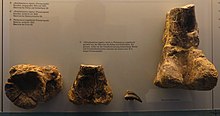
Summary
Gresslyosaurus (meaning "Amanz Gressly's lizard") is a genus of plateosaurian sauropodomorph dinosaur that lived during the Late Triassic period, around 214 to 204 million years ago, in France, Germany, Norway, Greenland and Switzerland.
| Gresslyosaurus Temporal range: Late Triassic,
~ | |
|---|---|

| |
| Gresslyosaurus ingens holotype | |
| Scientific classification | |
| Domain: | Eukaryota |
| Kingdom: | Animalia |
| Phylum: | Chordata |
| Clade: | Dinosauria |
| Clade: | Saurischia |
| Clade: | †Sauropodomorpha |
| Family: | †Plateosauridae |
| Genus: | †Gresslyosaurus Rütimeyer, 1857 |
| Type species | |
| †Gresslyosaurus ingens Rütimeyer, 1857
| |
| Other species[1] | |
| |
| Synonyms[1] | |
| |
Discovery and naming edit
The holotype of G. ingens, NMB BM 1, 10, 24, 53, 530-1, 1521, 1572-74, 1576-78, 1582, 1584-85, 1591, consists of postcranial remains discovered in the Late Triassic (late Norian-Rhaetian) Trossingen Formation or Knollenmergel Formation of northern Switzerland around 1840 by Amanz Gressly,[2] with more of the holotype being found between 1915 and 1942 by an unknown collector.[3] G. ingens was named and described by Rütimeyer (1857).[4]
The most complete remains of G. plieningeri were collected from the Marnes de Châlins Formation of France between 1982 and 1994, and the holotype, SMNS 80664, a set of postcrania, was collected from the Trossingen Formation of Germany by Pleininger in 1847.[5] G. plieningeri was named and described by Huene (1905).[6]
The holotype of G. robustus, UT (GPIT) B, a set of postcrania, was collected from the Trossingen Formation of Germany by Quenstedt in 1879.[6] G. robustus was named and described by Huene (1905).[6]
The holotype of G. torgeri, HMN MB III, a set of postcrania, was collected from a Plateosaurus bonebed within the Trossingen Formation of Germany by Jaeckel in 1909 or 1910.[7] G. torgeri was named and described by Jaeckel (1911).[8]
Taxonomy edit
Gresslyosaurus was originally dubbed "Dinosaurus gresslyi" by Rütimeyer (1856) on the basis of postcranial remains discovered in the Late Triassic (late Norian-Rhaetian) Knollenmergel of northern Switzerland, but that name is a nomen nudum as it was described in an abstract.[2] Dinosaurus was already in use for a therapsid, so Rütimeyer (1857) formally described the material as Gresslyosaurus ingens.[4]
Lydekker (1888) synonymized Gresslyosaurus with Zanclodon, but von Huene (1908) removed sauropodomorph material assigned to Zanclodon (which he assigned to Theropoda) and Gresslyosaurus along with Plateosaurus as sauropodomorphs.[9]
A number of authors (e.g. Steel 1970) listed Gresslyosaurus as valid, but Galton (1976, 1985, 1986) synonymized it with Plateosaurus based on comparisons with Plateosaurus material from Germany.[10][11][12][13] Moser (2003), however, found Gresslyosaurus to be generically distinct from Plateosaurus, and in their description of Schleitheimia, Rauhut et al. (2020) found a number of differences between Schleitheimia and Gresslyosaurus.[3][14]
Relationship to Gressly edit
In his 1865 book Die Urwelt der Schweiz, Oswald Heer notes that Amanz Gressly, who had been admitted to an asylum in the final years of his life, had become tormented by hallucinations that he had transformed into the Gresslyosaurus, his namesake dinosaur.[15]
References edit
- ^ a b "Gresslyosaurus". Fossilworks. Gateway to the Paleobiology Database. Retrieved 5 April 2021.
- ^ a b Rutimeyer, (1856). Dinosaurus gresslyi. Bibliotheque Universelle des Sciences Belles-Lettres et Arts, Geneve. September, 53.
- ^ a b Oliver W. M. Rauhut; Femke M. Holwerda; Heinz Furrer (2020). "A derived sauropodiform dinosaur and other sauropodomorph material from the Late Triassic of Canton Schaffhausen, Switzerland". Swiss Journal of Geosciences. 113 (1): Article number 8. doi:10.1186/s00015-020-00360-8.
- ^ a b Rutimeyer, (1857). Reptilienknochen aus dem Keuper. Allgemeine Schweizerische Gesellschaft fur de Gesammten Naturwissenschaften. 41, 62-64.
- ^ Pleininger, T. (1850). Prof. Dr. Plieninger, who had already previously explained that he only would talk about certain things if there was enough time after listening to the presentations by outside members, touched on the following subjects in an informal presentation, of which he subsequently deposited a written record in the archives]. Jahreshefte des Vereins für Vaterländische Naturkunde in Württemberg 8:161-172 [in German]
- ^ a b c F. v. Huene. (1905). Trias-Dinosaurier Europas [European Triassic dinosaurs]. Zeitschrift der Deutschen Geologischen Gesellschaft 57:345-349
- ^ O. Jaekel. (1910). The foot posture and way of life of the large dinosaurs. Zeitschrift der Deutschen Geologischen Gesellschaft 62:270-277 [in German]
- ^ Jaekel, O. (1911). The Vertebrates; An overview of the fossil and living forms. Berlin: Gebrüder Borntraeger.
- ^ F. v. Huene. (1908). Die Dinosaurier der Europäischen Triasformation mit berücksichtigung der Ausseuropäischen vorkommnisse [The dinosaurs of the European Triassic formations with consideration of occurrences outside Europe]. Geologische und Palaeontologische Abhandlungen Suppl. 1(1):1-419
- ^ R. Steel. (1970). Part 14. Saurischia. Handbuch der Paläoherpetologie/Encyclopedia of Paleoherpetology. Gustav Fischer Verlag, Stuttgart 1-87
- ^ P. M. Galton. (1976). Prosauropod dinosaurs (Reptilia: Saurischia) of North America. Postilla 169:1-98
- ^ P. M. Galton. (1985). Cranial anatomy of the prosauropod dinosaur Plateosaurus from the Knollenmergel (Middle Keuper, Upper Triassic) of Germany. II. All the cranial materials and details of soft-part anatomy. Geologica et Palaeontologica 19:119-159
- ^ Galton, Peter M. (1986). "Prosauropod dinosaur Plateosaurus (=Gresslyosaurus) (Saurischia: Sauropodomorpha) from the Upper Triassic of Switzerland". Geologica et Palaeontologica. 20: 167–183.
- ^ Moser, M. (2003). Plateosaurus engelhardti Meyer, 1837 (Dinosauria, Sauropodomorpha) aus dem Feuerletten (Mittelkeuper; Obertrias) von Bayern. [Plateosaurus engelhardti Meyer, 1837 (Dinosauria, Sauropodomorpha) from the Feuerletten (Mittelkeuper; Obertrias) of Bavaria]. Zitteliana Reihe B: Abhandlungen der Bayerischen Staatssammlung für Paläontologie und Geologie (in German and English). 24: 1–186. OCLC 54854853.
- ^ Heer, Oswald (1865). Die Urwelt der Schweiz (in German). Zürich : F. Schulthess. p. 66.
Der arme Grefly, welcher in Wahnfinn verfallen, ins Irrenhaus gebradjt werben mußte, wurde von dem Gedanfen gequält, daß er im diefen Gresslyosaurus verwandelt worden jei.


